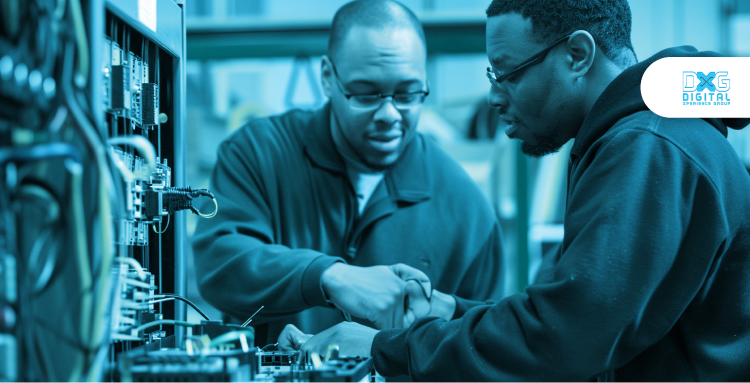


April 6, 2025
There’s a peculiar kind of magic that lingers in the air before an event begins- a soft hum of anticipation, a thousand unspoken possibilities weaving through the space. It’s the moment before the lights dim, before the stage comes alive before people become part of something larger than themselves.
And yet, so often, that magic is fleeting. It fizzles out, lost in the static of predictable routines and uninspired setups. Interactive AV technology is that touch, that spark. It doesn’t just fill a room with sound and light; it creates a world within the world. Shall we dive into how it's done?
Before you start choosing AV technology, get clear on what you want your event to achieve. This isn’t just about picking the flashiest tools; it’s about aligning your tech choices with your event’s purpose.
Why Setting Clear Goals Matters
When you have clear objectives, like driving audience participation or enhancing the learning experience, you can choose the technology that directly supports those aims. For example, tools like live polling or Q&A sessions will be key if you want to encourage networking or audience interaction. If your goal is to build excitement around a product launch, immersive experiences like VR or AR could be the way to go.
Know Your Audience
Next, think about who will be attending your event. The tech you choose should match your audience’s preferences and tech comfort level. Corporate professionals might appreciate polished, straightforward presentations with minimal distractions, while a younger crowd may lean toward more interactive or gamified features. If you’re hosting a mixed audience, consider offering multiple tech options, such as audiovisual services for corporate events that appeal to both ends of the spectrum.
With so many interactive AV options available, it can be tough to know where to start. Here are some top choices that can boost attendee interaction and create a more dynamic experience.
Touchscreens and Digital Kiosks: These are great for events where attendees need access to detailed information or schedules. By allowing visitors to interact with content on their own, you make it easy for them to navigate the event, explore product demos, or find session details. These displays can also be used to gather data or feedback from attendees, helping you engage with the audience while providing useful insights.
Digital Signage: Position digital screens throughout your event space to display live event updates, schedules, and important messages. This can keep attendees informed and involved while also providing a visually engaging way to deliver content.
Platforms like Slido or Mentimeter: Real-time interaction is a game changer at events. Tools like Slido and Mentimeter allow your audience to participate in live polls, ask questions, or provide feedback during presentations. This not only increases engagement but also helps keep the audience active and invested in the content. It’s a simple but powerful way to create a two-way conversation during talks, workshops, or panels.
Immersive Experiences: AR and VR offer some of the most innovative ways to engage attendees. By allowing them to interact with digital content in a real-world setting (AR) or enter entirely virtual environments (VR), you can create unforgettable experiences. For product launches or experiential marketing events, these tools let you showcase products in 3D and let attendees explore engaging event animations memorably.
Social Media Walls: A live social media wall can boost audience interaction by displaying posts, photos, and videos shared by attendees in real time. This encourages people to post using event hashtags, creating a sense of community while increasing visibility across platforms like Twitter, Instagram, or LinkedIn. It’s a great way to enhance social engagement in a virtual platform and get attendees involved in the buzz of the event.

Having the right interactive tools is only half the battle; making sure everything runs smoothly on event day is just as crucial.
Collaborate with Professional AV Providers
Work with AV professionals who have hands-on experience with the tools you've chosen. They can help set up, operate, and troubleshoot during the event. A skilled AV consultant ensures your technology works as planned, minimizing disruptions and improving the overall experience. They can also provide on-site support for any unexpected technical issues, so your focus stays on the event itself, not the tech.
Compatibility and Testing
It’s essential to test everything before the event to avoid issues. Ensure all devices and software are compatible and ready to go. This includes checking whether your interactive displays, polling platforms, and AR/VR tools integrate smoothly with your AV setup. Schedule a full tech rehearsal to run through the entire setup and identify potential issues. The more you test in advance, the less likely it is that you’ll encounter surprises.
Reliable Internet and Power Sources
Make sure you have a strong, stable Wi-Fi connection to support all the interactive features, especially if you plan on using live polling or streaming. You don’t want attendees experiencing lag or losing connection during a presentation.
Additionally, ensure there are plenty of power outlets throughout the venue to keep all devices running smoothly. A backup power plan is a smart move—think portable chargers or additional generators, especially if you’re hosting a large-scale event.
While you’re making the most of your interactive AV tools, here’s how to bring your event to life through content that keeps attendees connected and interested.
Dynamic Presentations
Traditional presentations can easily lose attention. Instead, use interactive slides, clickable elements, or gamified content that keeps your audience involved. For example, interactive quizzes or polls embedded directly in your slides can keep attendees thinking and engaged throughout the session. This transforms a passive experience into an active one, where participants feel like they are part of the presentation.
Personalization Options
Let attendees personalize their experience by choosing their session tracks, workshops, or activities. Personalized content options allow individuals to engage with the event in a way that matters most to them. This type of engagement not only boosts satisfaction but also keeps people actively participating.
For instance, offering a choice between different workshop topics or providing a personalized agenda based on their interests can make attendees feel more involved and in control of their experience.
Real-Time Data Display
Incorporate live data into your event experience to build excitement and encourage more participation. This not only makes the event feel more interactive but also motivates attendees to join in and contribute. Seeing live activity on the screens makes everyone feel more involved and invested in the event’s success.

Your event’s interactive experience will only be as smooth as the people running it. Make sure your staff is ready to support attendees and troubleshoot any tech issues that arise.
Train Your Team
Your team understands the interactive technology and can assist attendees when needed.
This means training your staff on how each tool works, from helping people navigate touchscreens to assisting with live polls or AR experiences.
A knowledgeable team will ensure that any technical hiccups are addressed quickly, allowing attendees to stay engaged without frustration.
Staff should also be prepared to explain features and guide users through interactive experiences, ensuring a seamless, stress-free event.
Provide Easy-to-Understand Guides
Even with training, some attendees may still need additional support. Make it easy for them to get help by offering clear, visual guides or help desks. Visual aids—such as posters or digital screens showing step-by-step instructions—will help attendees feel confident in using the technology.
Interactive technology doesn’t just engage your audience; it also provides valuable insights that can help you improve your events.
Gather Post-Event Feedback
After the event, use tools like live polls, surveys, or follow-up emails to gather attendee feedback on their experience with the interactive elements. Ask targeted questions about which tools they found most engaging or if there were any difficulties navigating the technology. This direct feedback will give you a clearer picture of how well your interactive features performed and where adjustments may be needed.
Use Event Analytics to Improve Future Events
In addition to attendee feedback, take advantage of the data collected during the event. Many interactive platforms offer detailed analytics, such as polling statistics, engagement rates, and social media activity. Analyzing these metrics will help you understand what kept your audience engaged and what didn’t.
For example, if a particular session saw high participation in live polls but low interaction with touchscreens, you can tailor future content and tech choices accordingly. This data-driven approach will allow you to refine your strategies and deliver even better experiences at your next event.
We understand that a truly successful event hinges on flawless execution. That’s why we take preparation to the next level, ensuring that every aspect of your interactive AV technology is thoroughly tested and rehearsed well in advance. Our team conducts comprehensive pre-event checks, evaluating everything from equipment compatibility and software functionality to wireless connections, leaving no stone unturned.
We know that even the most thorough planning can encounter unexpected bumps along the way. Our on-site tech experts are always on standby with troubleshooting guides and contingency plans to tackle anything that comes up, quickly and efficiently. We’re committed to providing a stress-free experience from start to finish, allowing you to focus on what truly matters—engaging and impressing your audience.